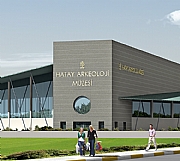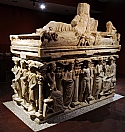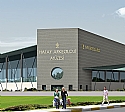Projects & Buildings

| Architect | Dr. M. Sinan Genim / Belma Barış Kurtel |
| Assistants | Özgen Esen / Elgün Poçan / Gökçe Şami |
| Employer | A Proposal to the Ministry of Culture and Tourism of the Turkish Republic |
| Static | Attila Çaydamlı |
| Mechanic | Selim Evyapan |
| Electricity | Korkut Daşdemir |
| Purpose | Museum |
| Project Year | 2008 |
| LandArea | 71.572 m² |
| Construction Area | 33.335 m² |

Many archaeological finds were revealed in Hatay region during the archaeological excavations that began in 1932. The idea to open a new museum to exhibit all these finds was brought forward by M. Claude Prost, the inspector of Antiquities of İskenderun Sancak in 1933. After some prework in 1934, M. Michel Ecocherde, the architect, made a project according to the standards of the time and began building the museum. In 1939, the building was completed and the artifacts in different parts of the province were gathered together in the museum. Perason, an American museum specialist, appointed by the Hatay State, accomplished the arrangement and organization of the musuem after a three and a half month work.
After Hatay joined the Turkish Republic in 29 June 1939, Ruhi Tekan became the director of the museum, and exhibitions and organizations continued. However, Hatay Museum opened after a long time, in 23 July 1948.
After the excavations conducted by the Princeton University in the vicinity of Antakya and the removal of the mosaics recovered from the Roman villas to the museum, it was clear that the museum did not have the necessary space to exhibit all these artifacts. Beginning from the 1970’s some additions were made to the museum. These additions turned out to be inadequate and in 1975 an additional building was built.
Hatay Museum is one of the most important mosaic museums of our country and the world, and actually the first one. It includes many of the mosaic samples recovered from the Roman villas dating from the 2nd century A.D. to the 4th century A.D. The mosaics dating to the Antoninus and Severus periods [2-3rd century A.D.] which are also called the classical period of the Roman mosaic art, occupy a great amount of space in the museum. Mythological deities such as Psykhe, Eros, Satyr, Aphrodite and Bacchus are depicted on the mosaics. Mythological scenes diminish beginning from the 4th century A.D. due to the spread of Christianity. Mosaics with depictions of seasons and daily life increase after this date.
In the present, the Hatay Museum comprises 1260 m² mosaics, of which a very little amount is exhibited. In addition, 75 m² mosaics has to go through restoration. Because there is not enough space in the museum, eight mosaic areas in and around Antakya are closed to excavation and the mosaics within are covered with soil. Many other mosaics come to light due to the various constructions in the city. They are trying to be conserved in situ, which increases depredation.
In the present there are 18009 archaeological artifacts in the inventory of Hatay Museum. Some of them are stone artifacts such as sculptures and sarchophagi, and very little amount are open to exhibition. Beside the archaeological artifacts, there are 14406 coins, 422 tablets and 1392 seals and seal impressions.
In spite of the abundance of the artifacts, there are only 722 archaeological artifacts [% 04], 656 coins [% 0.045] and 37 seals and seal impressions [% 0.026] in the exhibition, which demonstrate the necessity of a new museum.
Besides the inadequacy of the present, bearing in mind the 139 archaeological sites [in addition, an urban site and five natural sites] in the area of jurisdiction of Hatay Museum, the difficult situation of the museum can be understood easier. There are five excavations approved by the cabinet decree in 2008 in the area of jurisdiction of Hatay Museum. In the same year three salvage excavations were conducted by the museum. Especially the salvage excavations [five excavations in 2007] take too much time of the same museum.
Beside the Roman mosaics and stone finds, artifacts belonging to the Mitanni, Hittite and Assyrians recovered from the registered 183 mounds in Amuq plain, are difficult to exhibit due to inadequate space.
Although the Hatay Museum is famous for its mosaics, it is also the third largest museum in the world regarding its coin collection. The majority of the coins belong to the Roman and Byzantine periods. The coins were recovered from the excavations conducted in Harbiye, Antakya, Açana, Çevlik and İskenderun. In addition, various adornments recovered from the same excavations play an important role in the museum collection.
From now on, the funds must give a speed to an approach, in which cultural assets are put forward and better understood. We have cultural funds, which no other country possesses. The main problem is to bring these funds into play, organize and exhibit it. The first condition of this enterprise is to have modern and dynamic museums. It is not to be forgotten that museums are also education centers where remains of the past can be studied and with their inspiration people can head towards a modern life. The base of creativity and difference, which are mainly needed in the present world, is to be able to feed from its own culture. It is clearly observed that modern museums give support to education. Museums are not just buildings made of various materials. They have to turn into modern business centers, and the cultural assets that have been long ignored, have to be opened to the whole world. This static situation misunderstood as some kind of storage has to be renewed with a dynamic museum / business understanding.
A point not to be forgotten is the ethnography section within the same museum. To include an ethnography section in a museum where there are lots of archaeological artifacts, is a false administration. This brings along the mistake of one museum only in one city. An ethnography museum must be built in the city centrum, preferably in today’s museum area. This museum will act like an information center in the city centrum and may be used to attract attention to the archaeology museum. However, the goal here is to increase the number of the must-see sights in Antakya.
We hope that Hatay will gain not only one glorious museum, but several museums, so that it can exhibit the cultural assets to the world effectively.






